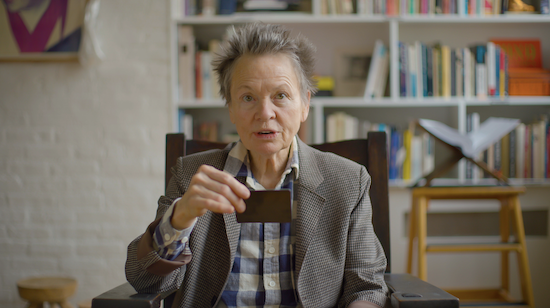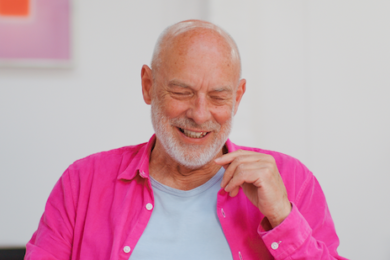“Why do films have to be the same every time?” asks Gary Hustwit, as we sit in a dressing room backstage in a Copenhagen theatre at the documentary festival CPH:DOX. “The idea of film as this linear, static, fixed piece of media needs to be evolved. It’s based on a technical constraint that we don’t have any more since everything is digital.”
In front of him on a laptop contains a piece of custom-built software that looks to fundamentally change the very nature of what film is and what it can do. Brain One was created in collaboration with the digital artist Brendan Dawes, and is the engine behind the new generative documentary Eno. Brain One is, of course, an anagram of Brian Eno, as well as being the proprietary software capable of producing a new film every time it is screened in real time. “This film that you will watch tonight doesn’t exist outside that moment,” explains Dawes. “You have to be there to experience it and once it’s over, it’s gone forever.”
Eno’s vast personal film archive was dug up, dusted off and digitised and – combined with fresh interviews with him – this provided a huge pool of footage for Brain One to pull from to weave together endless edits. However, while this might lead one to imagine a series of abstract images and clips being randomly spewed out with confusing intensity, the result is actually something much more measured, considered and coherent.
Later that evening, I watch modern day Eno dancing to tunes, shouting at YouTube adverts on his computer, talking through the Fela Kuti-inspired vocal arrangements on Talking Heads’ Remain In Light and pottering in his garden on the hunt for beetles. Then you’re thrown into the studio working with U2 in the 1980s, leap forward to the mid 1990s, and then come back to him today reflecting on creating the enduring soundtrack for the Apollo documentary For All Mankind. It’s unpredictable, non-linear and ever-shifting but it also all feels connected, logical and oddly thematic.
This is because the algorithm has been trained to respond to how the film is unfolding and shape its next steps based on tone and subject matter. So, for example, at one point David Byrne pops up on screen to pick an Oblique Strategies card at random and that then triggers where the film will go next based on what he picks. For filming, Byrne picked six different cards that each lead to different narrative pathways, and Laurie Anderson also did the same.

Laurie Anderson (potentially) in Eno
When the film premiered at Sundance it screened six different times, with unique edits for each. These were rendered and exported in advance to play as finished files. However, at CPH:DOX, for the European Premiere, as well as at the Barbican in April, the pair are presenting a live cut of the film.
So, the obvious question of course is: how does all this work? “There are parts of the film that are anchored,” Hustwit tells me. “There’s an opening and closing scene with Brian and they are always there. And then there are several scenes within the film that we’ve pinned to occur in specific regions of the runtime. So there is a skeleton of structure – and that’s probably 25% of the film. The other 75% is pulling from a vast number of edited scenes that could possibly come in, along with raw material. Plus, the system is also making its own scenes, generatively, that are unique to each cut as well as generating its own 5.1 audio mix in real time. These generative scenes are pure art that’s happening in the moment that are never repeated.”
You can literally see Brain One at work on screen too. “It sometimes shows the code,” Hustwit says. “The software itself is part of the visual aesthetic of the film. We were trying to show the process of making the film, and I think you end up appreciating what’s happening more when you’re seeing a little bit of what the system is doing.” The aim of the film is to create a one-off experience that is more akin to seeing a gig than a traditional film screening. “I wanted the film to be more like live music where even if you’re playing the same song every night, you can change it,” Hustwit says. This also results in a fascinating exploration around audience expectation. When you come into a film about Eno, you may have certain expectations around what you will, or should, see. This obliterates assumption or predictability and it also means you may not get the film you want. What has been created here is an experience that can equate to going to see your favourite artist hoping for a greatest hits show and instead they hammer out the B-sides and obscurities.
“We were asking ourselves: can you watch a documentary about Brian Eno that doesn’t mention Roxy Music?” asks Hustwit. “We posed it to Brian and he’s like, ‘Yes! Why does something that I did 50 years ago have to be talked about every time someone talks about me?’ So you might see the Roxy Music or the David Byrne part this time or you might have to watch it a few more times. There’s no way you can encapsulate what he’s done in the last 50 years, even in an entire series about him. This is a way to include a lot of that material but you’re only seeing a piece of it each time you watch.”

It’s a fascinating experience to watch the film. The idea of what constitutes a definitive exploration or telling of an artist’s life and work is completely unmoored here and the very definition of a definitive documentary is also challenged. Eno seems to exist to refute the idea that a single story or retelling is capable of meeting that definition. Instead, it basks in the malleable, conflicting and contrasting nature of a person’s life and art while also connecting themes that run through all of that change and ceaseless evolution. The film asks, more by its very existence than the contents, how can anything that is alive and endlessly moving be documented definitively? The film’s tagline of being the definitive documentary on its subject instead comes more from its endless possibilities and outcomes, rather than existing in a rigid framework.
It also feels like an especially peculiar film to write about with any sense of convention or traditional thought processes because the film also kind of exists to render traditional film reviewing utterly obsolete. What I saw and experienced will be completely different to what everyone else will. There’s no sense of shared experience other than with those who were in the room with you. The notion of reading something about a film as an indicator of quality or in terms of seeking recommendation is completely out of the window here but it also poses the question of if there is actually anything to be gained from engaging with a critical analysis of a film that no longer exists and people can never see. It’s a bit like reading the forecast for yesterday’s weather.
Another key approach is how this shifts storytelling power more into the hands and minds of audiences. In many ways, they become the editors of their own film, rather than a spectator of someone else’s. “The viewer makes the connections between these different scenes and ideas,” Hustwit says. “And over the course of 90 minutes, they tell their own story about the subject. They’re not being told the story, they’re doing their own piecing together.”
I watch version 2.1. The first six screenings of the doc were versions 1.1-1.6 but given the film has been altered since then, it is already into its second generation. “We’ve added 25 new scenes since Sundance,” Hustwit says. “There’ll be a third generation in the spring, and then maybe a fourth or fifth. Each time we’re changing the content and adding things but we’re also refining the software and making changes to that. So the version that people see in November is going to be much different than this. The point is that it doesn’t have to have an end or a fixed iteration.”

Gary Hustwit, portrait by Ebru Yildiz
Ultimately, Eno sets out to challenge fundamental ideas around memory, identity, legacy and finality in documentary making. “Brian said he always feels there’s multiple truths about people,” says Dawes. “And this film, and the way it is made, allows that to happen.” However, while this could easily exist as a smoke screen to avoid getting anything meaningful, reflective or of any real substance out of its central character – to hide behind the process – it appears the opposite may be true. Perhaps the forward-facing and innovative nature of the film has created a more comforting place for Eno to open up, knowing that he’s not going to be appearing amongst a sea of talking heads and tired anecdotes being dug out.
In one scene, of the version I saw, Eno speaks candidly and emotionally about how bruised he was by negative criticism of his ambient music and how he felt he became a synonym for wimpy music. He says it rattled his confidence to such a degree that he turned down making an ambient album with Joni Mitchell. The regret he expresses even today over that decision feels palatable on screen. It’s a rare and beautiful moment to sit with him as he expresses sincere regret, given how much he’s positioned himself as being anti-looking back.
Similarly, his latest song, taken from the film’s soundtrack, ‘All I Remember’ is one of the most straightforwardly sentimental and reflective songs Eno has ever written. “I have noticed that throughout the five-year process of making the film that he’s gotten a little bit more nostalgic,” says Hustwit. Although there is a limit to Eno’s desires to look back it would appear. “He still doesn’t want to watch the film,” laughs Hustwit. “He is his least interesting subject is what he says.”
So, how do you release a film to the world that is supposed to be unique each time? “The last thing I want to do is make a director’s cut,” says Hustwit. “The only thing that the film industry wants is the director’s cut because nobody can deal with the technology that we’ve made. None of the streaming platforms has the technology to be able to give you as a subscriber your own original version. So we’ve launched our own startup company, Anamorph, to explore this idea of how do you stream generative video? Yes, we could generate 10,000 cuts and stream those to individual people but there is a different way to do it.”
It’s really not an exaggeration to state that what has been created here potentially holds revolutionary capabilities. The very existence of Eno is a template for how cinema can be re-defined in the digital age. “No one’s ever done this and it opens up a ton of questions about our assumptions of what a movie or documentary is and what’s possible,” says Hustwit. “If Christopher Nolan said my next film will never be the same twice, the industry would change. Everybody would flip out and it would break all kinds of boundaries. Eno is just an opening statement for what we’re trying to do.”



